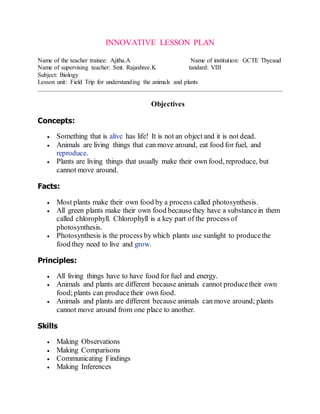
Innovative lesson plan ajitha
- 1. INNOVATIVE LESSON PLAN Name of the teacher trainee: Ajitha.A Name of institution: GCTE Thycaud Name of supervising teacher: Smt. Rajashree.K tandard: VIII Subject: Biology Lesson unit: Field Trip for understanding the animals and plants Objectives Concepts: Something that is alive has life! It is not an object and it is not dead. Animals are living things that can move around, eat food for fuel, and reproduce. Plants are living things that usually make their own food, reproduce, but cannot move around. Facts: Most plants make their own food by a process called photosynthesis. All green plants make their own food becausethey have a substancein them called chlorophyll. Chlorophyll is a key part of the process of photosynthesis. Photosynthesis is the process bywhich plants use sunlight to producethe food they need to live and grow. Principles: All living things have to have food for fuel and energy. Animals and plants are different because animals cannot producetheir own food;plants can producetheir own food. Animals and plants are different because animals can move around; plants cannot move around from one place to another. Skills Making Observations Making Comparisons Communicating Findings Making Inferences
- 2. Drawing Conclusions Materials: 1. Large pieces of drawing paper 2. Pencils, crayons, magic markers 3. May take something stiff to put paper on while drawing 4. Outdoors area with many critters and plants Room Preparation None—Going Outdoors! Safety Precautions Dress appropriately for the weather. May need insect repellant. Procedures and Activity Introduction Ask the guiding questions: 1. What is a living thing? Share examples of living and non-living things. Help children see that all living things are "alive"—they aren’t dead but will die someday. All living things grow, need food, and reproduce. 2. What is an animal? Share examples of animals. Help children see that animals have to eat, but they cannot producetheir own food. They eat other animals and plants. Most animals can move around from one place to another. Animals don’tall get around in the same way. Some run, while others walk, creep, fly, or hop. 3. What is a plant?
- 3. Discuss examples of plants. Then think about what makes all these plants alike or similar. For example, plants all grow and need air, usually dirt or soil, water, and sunlight. Plants can produceother plants like themselves. Many plants are green. Share the idea of plants using photosynthesis as a way to make food by turning sunlight into fuel and energy. Add that most plants can’t move around and get from one place to another. Activity 1. Continue the discussionto figure out how plants and animals are different. Help them come to some understandings such as that plants can make their own food;animals cannot. Animals can move around from place to place; plants cannot. 2. Today, we are going on a walk to be scientists and investigators. We are going to look for examples of plants and animals. There are lots and lots of them around us every day, but most of the time we don’tlook for them! 3. Pass out drawing paper. Have them fold the paper in half and then unfold paper. Draw a line down the middle of the paper. 4. On the right hand side, write the word “animals” at the top. 5. On the left hand side, write the word “plants” at the top. 6. Explain that they are to identify the plants and animals they find on our walk. They may use words, pictures, or both. 7. Go on walk and let children observe, identify, classify and record information. Remind them that these skills are what scientists use every day. Evaluation Closing - Original Question Back in the classroom, ask again: 1. What is a living thing? 2. What is an animal? 3. What is a plant?
- 4. Listen as children share examples of plants and animals. Have them offer explanations for why they classified different things the way they did. Encourage them to define characteristics of all living things and then of plants and animals.